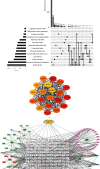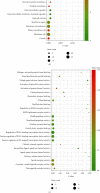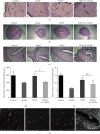TJZYF Improves Endometrial Receptivity through Regulating VEGF and PI3K/AKT Signaling Pathway
- PMID: 36193314
- PMCID: PMC9525772
- DOI: 10.1155/2022/9212561
TJZYF Improves Endometrial Receptivity through Regulating VEGF and PI3K/AKT Signaling Pathway
Retraction in
-
Retracted: TJZYF Improves Endometrial Receptivity through Regulating VEGF and PI3K/AKT Signaling Pathway.Biomed Res Int. 2023 Dec 29;2023:9846512. doi: 10.1155/2023/9846512. eCollection 2023. Biomed Res Int. 2023. PMID: 38188825 Free PMC article.
Abstract
The endometrium receptivity was impaired by controlled ovarian hyperstimulation (COH), which would then lead to fertility issues and increased abortion clinically. In the present study, to explore the effectiveness of Tiaojing Zhuyun Formula (TJZYF) in improving endometrial receptivity of COH rats and the possible active ingredients and mechanisms, an approach of network pharmacology was performed and a COH animal model was established. As analyzed, stigmasterol and quercetin may be the active ingredients of TJZYF on improving endometrial receptivity and positive regulation of ion transport, the cytokine-mediated signaling pathway, and endocrine process, and vascular endothelial growth factor receptor signaling pathway may be involved. Eighty female rats were divided into four groups randomly: control, model, TJZYF, and TJZYF+si-VEGFA. COH rat models were constructed by injecting with human menopausal gonadotropin (HMG) and human chorionic gonadotropin (HCG). We found that both endometrial thickness and number of embryo implantations in model were substantially reduced vs. control. The gene and protein expressions of VEGF, PI3K, and p-Akt in the uterus were significantly reduced. TJZYF could increase the endometrial thickness and number of embryo implantations and enhance the expressions of VEGF, PI3K, and p-Akt in the uterus. In the TJZYF+si-VEGFA group, the effect of TJZYF was impaired. Generally, TJZYF could improve the endometrium receptivity and facilitate embryo implantation of COH rats by upregulating VEGF and enhancing the PI3K/Akt signaling pathway.
Copyright © 2022 Fang You et al.
Conflict of interest statement
The authors declare no conflicts of interest.
Figures







Similar articles
-
High-frequency electroacupuncture improves endometrial receptivity via regulating cell adhesion molecules and leukemia inhibitory factor / signal transducer and activator of transcription signaling pathway.Bioengineered. 2021 Dec;12(2):10470-10479. doi: 10.1080/21655979.2021.1997367. Bioengineered. 2021. PMID: 34898339 Free PMC article.
-
[Effect of GnRHa controlled ovarian hyperstimulation on mouse embryo implantation and its mechanism].Sheng Li Xue Bao. 2018 Oct 25;70(5):489-496. Sheng Li Xue Bao. 2018. PMID: 30377687 Chinese.
-
Tiaojing Cuyun Recipe Enhances Pregnancy Outcome via the VEGF/PI3K/AKT/eNOS Signaling Pathway in EID Mice.Dis Markers. 2022 Feb 24;2022:9461444. doi: 10.1155/2022/9461444. eCollection 2022. Dis Markers. 2022. PMID: 35251378 Free PMC article.
-
Role of Vascular Endothelial Growth Factor (VEGF) in Human Embryo Implantation: Clinical Implications.Biomolecules. 2021 Feb 10;11(2):253. doi: 10.3390/biom11020253. Biomolecules. 2021. PMID: 33578823 Free PMC article. Review.
-
Ion channels in the endometrium: regulation of endometrial receptivity and embryo implantation.Hum Reprod Update. 2014 Jul-Aug;20(4):517-29. doi: 10.1093/humupd/dmu006. Epub 2014 Mar 2. Hum Reprod Update. 2014. PMID: 24591147 Review.
Cited by
-
Shoutai Pill Enhances Endometrial Receptivity in Controlled Ovarian Hyperstimulation Mice by Improving the In-Vivo Immune Environment.Comb Chem High Throughput Screen. 2025;28(4):711-723. doi: 10.2174/0113862073274708231028185333. Comb Chem High Throughput Screen. 2025. PMID: 37929727
-
The lncRNA LINC00339-encoded peptide promotes trophoblast adhesion to endometrial cells via MAPK and PI3K-Akt signaling pathways.J Assist Reprod Genet. 2024 Feb;41(2):493-504. doi: 10.1007/s10815-023-02995-6. Epub 2023 Dec 5. J Assist Reprod Genet. 2024. PMID: 38049704 Free PMC article.
-
Retracted: TJZYF Improves Endometrial Receptivity through Regulating VEGF and PI3K/AKT Signaling Pathway.Biomed Res Int. 2023 Dec 29;2023:9846512. doi: 10.1155/2023/9846512. eCollection 2023. Biomed Res Int. 2023. PMID: 38188825 Free PMC article.
-
Neutral effect of Zishen Yutai Pill on frozen-thawed embryo transfer: a propensity score matching study.Front Endocrinol (Lausanne). 2024 Aug 29;15:1379590. doi: 10.3389/fendo.2024.1379590. eCollection 2024. Front Endocrinol (Lausanne). 2024. PMID: 39268234 Free PMC article.
References
-
- Chachamovich J., Chachamovich E., Ezer H., Fleck M. P., Knauth D., Passos E. P. Investigating quality of life and health-related quality of life in infertility: a systematic review. Journal of Psychosomatic Obstetrics and Gynaecology . 2010;31(2):101–110. doi: 10.3109/0167482X.2010.481337. - DOI - PubMed
Publication types
MeSH terms
Substances
LinkOut - more resources
Full Text Sources
Research Materials

